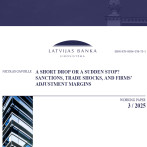Latvia's current account deficit was 4.6% of GDP in the third quarter
In the third quarter of 2024, the current account of Latvia's balance of payments registered a deficit of 460 million euro, i.e. 4.6% of gross domestic product (GDP). In the first three quarters of the year, the deficit amounted to 931 million euro, equivalent to 3.2% of GDP.
Following a year-long break, the value of Latvia's exports has slightly increased year on year, with Latvia's exports experiencing more positive trends in the services sector. Global uncertainty remains high, and potential US tariffs on exports from the European Union could also hinder more buoyant economic growth and recovery in trade. While the US is not a significant export partner for Latvia, it is an important partner for our largest export markets, and therefore, in the event of tariff imposition, Latvia's exports may suffer indirectly. If the US were to impose customs tariffs on China, Chinese exporters might increasingly turn towards Europe, further intensifying the market competition for Latvian exporters, who are already experiencing signs of deteriorating competitiveness in terms of costs.
This year's harvest was better
While there were no major changes in goods exports in the third quarter, a slight year-on-year increase can be observed – the export value of wood products increased slightly. Moreover, it might recover and grow more rapidly in the future alongside the reduction of interest rates (both in the euro area and in Sweden, where they are being reduced even more quickly). This summer's agricultural harvest was better than a year ago, and so the exports of agricultural products, including exports of grain, have increased. Exports of mechanical appliances and electrical equipment have been relatively stable as demand for these goods has been more resilient, with no distinct cyclical fluctuations.
Weak investments drive slow import growth
In the third quarter of this year, goods imports decreased only slightly year on year, as consumption did not grow rapidly and investments in the Latvian economy declined (as mentioned in the commentary on Latvia's GDP dynamics in the third quarter). Imports of mineral products have declined year on year – the value of imported gas, oil products, and electricity has decreased, with their prices falling below the last year's levels. Meanwhile, energy prices have been rather volatile in response to various geopolitical tensions near and far around the world. Among other goods, only imports of machinery and electrical equipment have seen a larger decline, while imports of other goods have remained largely unchanged.
On a more positive note, the value of services exports reached a record high in the third quarter
In the third quarter, exports of travel and transport services increased and the activity of visitors from abroad grew – trends typical for the season. The fastest-growing component of transport services has been road transport. Meanwhile, air transport did not sustain its rapid growth in the third quarter. Among other services, telecommunication and computer services continued on an upward trend, while exports of other business services maintained a value similar to that of last year. Although the value of services exports in Latvia has reached a record high, it should be noted, however, that, in the context of the Baltic States, services exports from Latvia have fallen behind those of Lithuania and Estonia, with Lithuania experiencing rapid growth in road transport and financial services and Estonia recording faster export growth in ICT and other business services sectors.
Services imports have not lagged behind exports and have even grown at a faster rate
With the purchasing power of Latvian consumers recovering, people are showing more interest in travelling – Latvia's residents are travelling abroad more than foreign visitors are coming to Latvia. Imports of construction services have increased likely due to Rail Baltica construction works. With more such works underway, this trend is also set to continue in the future. Imports of other services have remained broadly unchanged, and only imports of other business services (such as trade-related services) have grown.
Foreign direct investments remain strong
Foreign direct investments reached 327 million euro or 3.2% of GDP in the third quarter and 658 million euro or 2.3 % of GDP in the first three quarters of the year. Investments were largely made in professional, scientific, and technical activities, as well as in financial and insurance activities. As usual, the largest investments came from Sweden and Estonia, as well as from Denmark.
Textual error
«… …»






